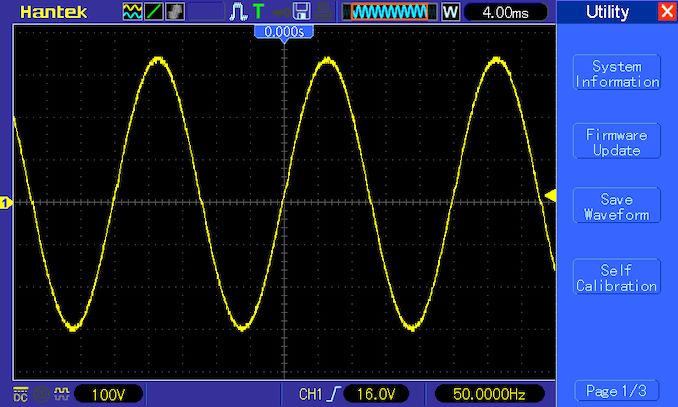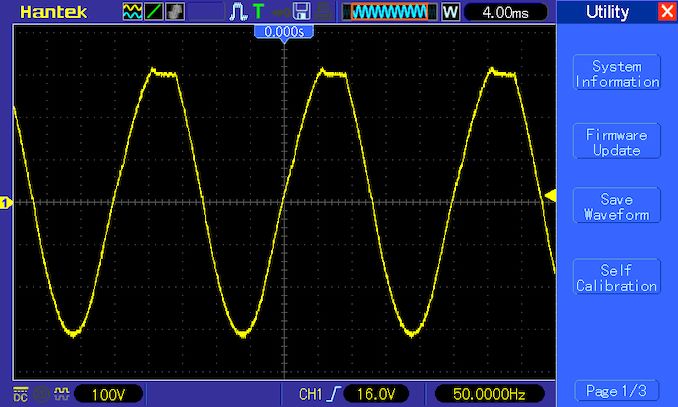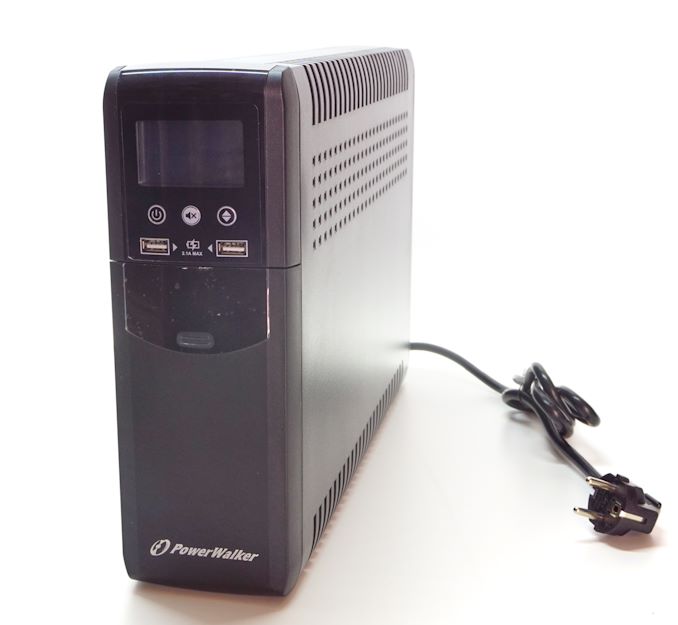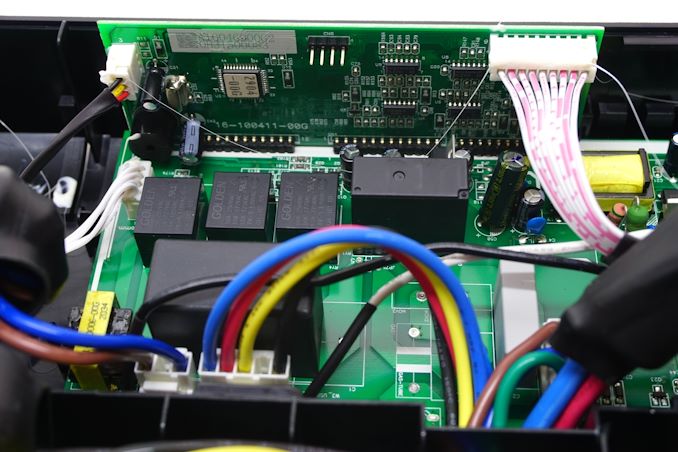The PowerWalker VI 1500 CSW UPS Review: Trying For True Sinewave on a Budget
by E. Fylladitakis on April 13, 2022 8:00 AM EST- Posted in
- Cases/Cooling/PSUs
- UPS
- PowerWalker
- BlueWalker
- 1500VA
Testing
Putting the PowerWalker VI 1500 CSW to the test, the basic electrical figures of the UPS are acceptable, with the unit delivering the performance it promises. When it operates on battery power, the voltage output is exactly 224 V RMS regardless of the load. There are minor frequency variations but these are exceptionally small. The transfer time is relatively high, yet not out of the manufacturer’s specifications. Though it also seems to significantly depend on the load, which should not be happening to this extent.
| UPS Load Performance | |||||
| 10% | 25% | 50% | 75% | 100% | |
| Voltage Output (Vrms) | 224 | 224 | 224 | 224 | 224 |
| Frequency (Hz) | 50.05 | 50 | 50 | 49.95 | 50 |
| Transfer Time (ms) | 6.1 | 7.6 | 7.8 | 7.6 | 8.9 |
The fan of the unit outputs 41.6 dB(A) once it is running. By UPS standards this is not a very high figure, but it's certainly not a very comfortable amount of noise, either. The downside here is that the PowerWalker VI 1500 CSW requires nearly 10 hours to fully charge its batteries once they are completely empty, which could be a problem with the unit installed in a living room or, worse, bedroom.
In our load testing, we've found that the battery runtime of the PowerWalker VI 1500 CSW is even better than advertised. These figures are achieved with its batteries fully charged and while they are new.
The PowerWalker VI 1500 CSW boasts true sinewave output, and our testing confirms this. Under load, our instruments showing a nearly-perfect sine wave with the unit running on battery power – but only while the load is low. Once the load reaches 50% (450 Watts) the deformation of the sine wave becomes apparent. It also becomes deformed abnormally, with only the positive peaks getting chopped, meaning that it is only one half of the circuitry failing to perform. At nearly 90% load (800 Watts) the waveform is nearly square, with both peaks heavily chopped, suggesting a massive number of harmonics. This will definitely not be healthy for any device that requires a pure sinewave input, such as APFC circuitry and AC motors.
Conclusion
The PowerWalker VI 1500 CSW is a UPS designed to combine a high output and true sinewave capability at a retail price affordable for most home consumers. At around €180, it currently retails for half of the price reputable manufacturers ask for their equally powerful true sinewave products, making it a very enticing deal.
The build quality of the PowerWalker VI 1500 CSW is better than one would expect from a product retailing at this price. Its parts are coming from reputable manufacturers and the unit is very well assembled. The design is dated but that is not inherently wrong – it just means the unit isn't geared to deliver the kind of top-of-the-line performance that more recent designs can provide.
When it comes to performance, the PowerWalker VI 1500 CSW performs, for the most part, according to its specifications. The trade-offs and issues become apparent when a closer look is taken, revealing that its electrical performance leaves a lot to be desired. The unit fails to maintain a true sinewave output when the load exceeds about 25% of its rated capacity, which could lead to serious issues if an application requires a true sinewave input. To be sure, for most home applications like modern PCs and TVs, this will not be a significant issue, as they take measures against harmonics and the expected load is usually but a fraction of the unit’s maximum output. However, if the unit needs to run at its maximum output or to drive loads that are very sensitive to harmonics, such as electric motors or older PCs, it could have damaging results to the equipment.
Ultimately, for users who are currently on the market for a UPS that is expected to mostly run at low loads, such as for safeguarding a single PC and its peripherals, the PowerWalker VI 1500 CSW is a fine choice. The UPS offers a clean enough electrical feed to meet the needs of a PC (or similarly switching power supply device), and it has the headroom to handle the stress if the power outage happens when the system is very heavily loads (e.g. while gaming). However, it is very clearly a device that was designed against engineering trade-offs to bring down costs for its target market. So, due to its inability to maintain a clean true sinewave output, we cannot recommend it for sensitive applications, and prospective users will want to be especially careful analyzing the sensitivity of their equipment to harmonics before purchasing it.
















107 Comments
View All Comments
Oxford Guy - Friday, April 15, 2022 - link
‘The typical usage model is that the user saves their work, shuts down their PC, and then switches off the UPS. You're not necessarily supposed to run until the battery is 100% depleted.’This device can be depleted within minutes. How quickly is someone going to prevent the batteries from draining at all, let alone completely? People are not always at their PC. People take bathroom breaks, get snacks, et cetera.
Lead-acid tech is fundamentally incompatible with this usage model. It is that simple. The only usage model that is at all justifiable is having lead-acid batteries as an additional optional emergency capacity mode, to supplement a typically-adequate (capacity) lithium primary battery.
There is no justification for polluting the planet with batteries that are intentionally lifespan-shortened. The biosphere is in bad shape already, without being intentionally more reckless.
Even for those who don’t have a conscience and thus care not about ecological product justification, they need to grant that basic logic shows there is a severe mismatch between the workload and the solution chosen.
mode_13h - Friday, April 15, 2022 - link
> This device can be depleted within minutes.Runtime is determined by capacity / load. That it *can be* doesn't mean it *always is*. Even if you buy the minimum capacity needed for your load, that would be *peak* load. As we all know, modern computers can burn a lot of power at full load, but not much at idle. And, unless you're gaming or doing other heavy-duty computation, PCs are typically running closer to idle than peak.
> People are not always at their PC. People take bathroom breaks, get snacks, et cetera.
Yes. As I mentioned, my workplace typically gets about 5 years out of a battery, even though there's probably an average of 1 full discharge per year.
> Lead-acid tech is fundamentally incompatible with this usage model.
It's worked well enough for 3-4 decades. True, it's not ideal, but the batteries aren't a major cost item for the amount of time they last. I mean, relative to the cost of what's plugged into the UPS and its rate of depreciation.
> There is no justification for polluting the planet with batteries
And here's where I figured we'd end up. Like all things, it's a matter of cost/benefit. People should dispose of their batteries properly, but of course that process isn't perfect and not everyone is going to do it. So, I agree that lead acid is a dirty technology, but Lithium Ion also has environmental impacts. As and when better technologies become competitive, I'd like to get away from the tremendously heavy & dirty lead acid tech.
> basic logic shows there is a severe mismatch between the workload and the solution chosen.
No, it's not severe. You're overstating your case, which distracts from your core message.
Oxford Guy - Saturday, April 16, 2022 - link
‘You're overstating your case, which distracts from your core message.’That is your opinion.
bunkle - Tuesday, April 19, 2022 - link
Seems a lot of people think a UPS is equivalent to a power wall and don't really understand the designed use cases. They're for short term use so you can switch from one power source to another, prevent brownouts or enable automated clean shutdowns. I run a 3K VA UPS at hone that's attached to the mains and an LPG/Petrol generator. You'd be surprised how often brownouts occur, even last night it protected my machines:Date : 04/19/2022, Time : 02:36:12, Code : 0x0109
Warning - UPS: On battery power in response to distorted input.
Date : 04/19/2022, Time : 02:36:13, Code : 0x010A
Informational - UPS: No longer on battery power.
Given the fact that lead acid batteries are the top recycled consumer product in the US with 99% recycling rates, one could argue that lead acid is far cleaner than any Lithium based alternative. The batteries are also standardised and you don't get locked into using a vendor's specific replacements.
Oxford Guy - Thursday, April 21, 2022 - link
‘Seems a lot of people think a UPS is equivalent to a power wall and don't really understand the designed use cases.’That explains the use of lead batteries when people can need to do things like use a restroom or answer the door. Lead batteries are permanently degraded within minutes with these devices.
mode_13h - Friday, April 22, 2022 - link
> Lead batteries are permanently degraded within minutes with these devices.Your characterizations simply don't match my experiences. Your warnings sound very dire, but the 5-7 years I've gotten out of these batteries would argue otherwise.
I've long used AGM lead-acid batteries in my cars. I've even treated them somewhat roughly, especially during the pandemic, and yet still averaged about 5 years out of them.
If you want to keep pressing this case, then please provide some data on the specific battery tech used in these UPS units.
Oxford Guy - Thursday, May 12, 2022 - link
You don’t understand that lead acid batteries don’t work like lithium batteries. They are degraded when they are even partially discharged. The only workload they’re suitable for is one where the battery is only slightly discharged, like with starting a car.kpp - Thursday, April 14, 2022 - link
Very nice and technical review, as always from mr Fylladitakis. The only thing I believe is missing is a measure of the UPS power consumption while on standby with the batteries charged. In my experience, this consumption can range from 10W (very good "green" UPS) up to 50W (typical APC UPS). This consumption can contribute significantly to the Total Cost of Ownership of the UPS.mode_13h - Thursday, April 14, 2022 - link
> up to 50W (typical APC UPS).Not unless it's charging. Common sense should tell you that if it's burning 50 W, its fan must run to keep it from overheating. The only time mine runs is while charging or discharging. And I have a 1500 VA model, which is at the upper end of capacity for a desk-side UPS and even has a backlit front panel LCD. Also, it's a model with Sine Wave output.
APC publishes Load/Efficiency specs, on their website. For my SMC1500, they claim:
Load | Efficiency
--------------------
25% | 96.1%
50% | 97.6%
75% | 97.9%
100% | 98.0%
mode_13h - Thursday, April 14, 2022 - link
Translating that into Watts, I think it'd be:Load | Overhead
---------------------
225 W | 9 W
450 W | 11 W
675 W | 14 W
900 W | 18 W